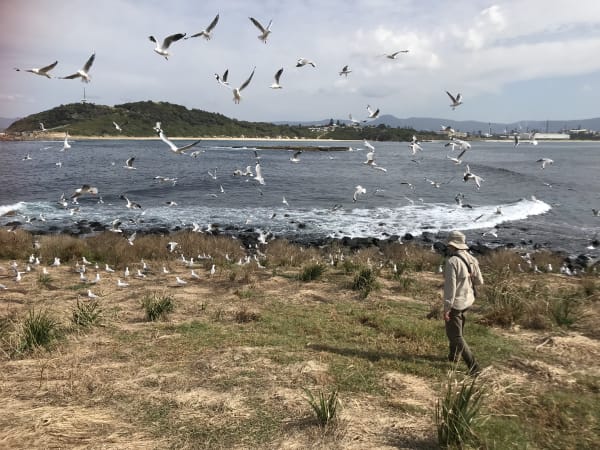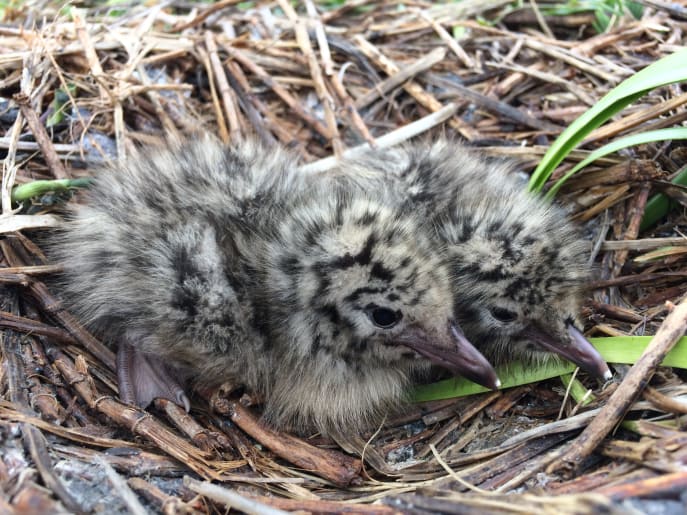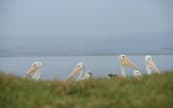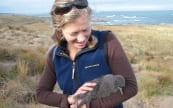Offshore wind farms might affect seabirds. But we don’t know how much or what to do about it. And if Australians don’t fight for their right to know, then the unique environmental data gathered during feasibility research could remain the commercial in-confidence property of foreign-owned companies. Genevieve Swart reports.

How many birds are on the Five Islands?
“Ah,” says University of Wollongong scientist Dr Bethany Hoye, “that’s a tricky one.”
Wollongong’s Five Islands are famously home to a large colony of silver gulls, but the nature reserve is also an avian meeting place where land and ocean foragers come to breed.
“Historically, there were estimates around 30 to 50,000 pairs of silver gulls breeding out there,” Bethany says. “But there aren't, to my knowledge, good numbers for the other species.
“There's – on again, off again – white-faced storm petrels, short-tail and wedge-tail shearwaters, ibis, little penguins, pelicans, and probably two species of terns.”
The prospect of wind turbines 20km off the Illawarra coast has shone a light on how little we know about what lies beneath or flies above our ocean.
“It’s a zone that we've never had the opportunity to look at,” Bethany says. “And now it's absolutely critically important.”

Rumours fill the void
Bethany has seen “wildly inaccurate” information bandied about, from concerned birdwatchers who haven’t been able to quantify risks to world-leading climate scientists who haven’t taken into account key differences between seabirds in northern and southern hemisphere wind zones.
"Essentially, in high winds their birds flap near the surface, our birds soar on the wind," Bethany says. "Theirs migrate on predictable schedules (including periods of absence), while the Illawarra hosts different species that come and go on different schedules throughout the year."
Existing research focuses on gulls and terns in the North Sea, which fly by flapping their wings, Bethany explains, while in the Pacific Ocean off the Illawarra we have albatross and petrels. “They fly by ‘dynamic soaring’ – where they use the wind over waves to lift themselves high above the ocean, then use this height, and the higher wind speeds at these elevations, to glide long distances.
“This way of flying means that the seabirds foraging in the Illawarra could be at greater risk of collisions with turbine blades and/or displacement from the area than flapping species, because flapping species are more capable of adjusting their trajectories to avoid installations.”
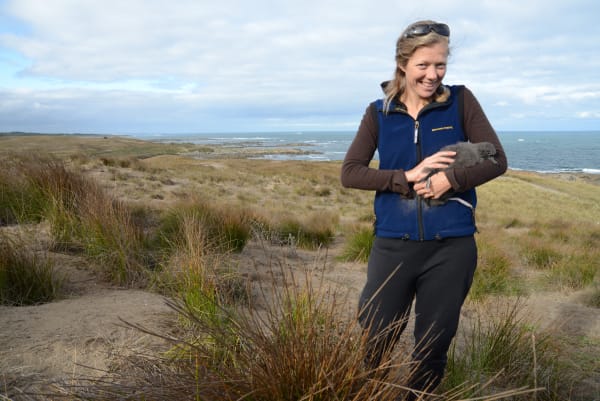
North versus south
Skill and serendipity have combined in Bethany’s career to give her crucial knowledge to contribute to offshore wind discussions.
A senior lecturer in animal physiology, Bethany is an ARC DECRA Fellow in the Faculty of Science, Medicine and Health, School of Earth, Atmospheric and Life Sciences at UOW. She grew up in Orange, studied and did her honours at UOW in moult physiology (how much energy birds used to change the feathers), which was when she had her first up-close encounter with an albatross, thanks to the citizen scientists at Unanderra charity Southern Oceans Seabird Study Association (SOSSA).
Bethany then did her PhD in the Netherlands on migratory ducks, geese and swans and their interactions with the influenza virus, and worked on multiple parasites in frogs in Colorado before returning to Australia to study migratory shorebirds, including the 36 species that use the ‘East Asian-Australasian Flyway’. Now back at UOW, she has spent the past seven seasons working with silver gulls on the Five Islands, tracking their movements to understand how they forage and come into contact with human pathogens.
Decades of local and international experience have given Bethany the authority to point out “stark biological differences” between Europe and Australia that mean knowledge is not necessarily transferable.
“In the northern hemisphere, you've got a lot of land,” she says. “And in the southern hemisphere, you've got a lot of ocean, which fundamentally changes how the seabirds in those spaces move.
“The Southern Ocean's really dominated by species that are using this dynamic soaring … they need a lot of height, but we just know next to nothing about how high they go.”
She questions if pausing turbines during “migration season” would work in the Illawarra, as at least nine species of albatross are present in any given month. “The overwhelming zeitgeist is that the albatross are here in the winter. But that's not necessarily what SOSSA data shows.”
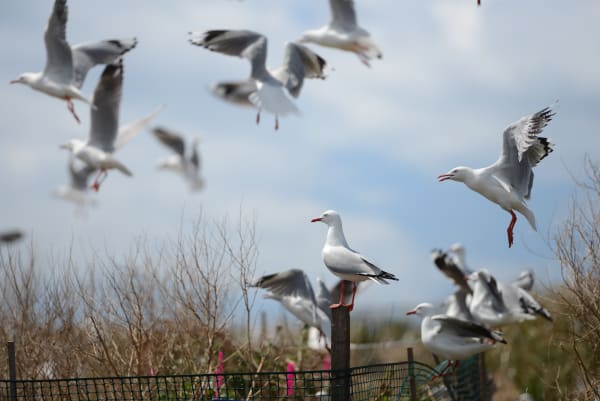
Community groups Illawarra Birders and SOSSA made a joint submission critical of an Illawarra wind farm and Bethany acknowledges their local expertise. “The idea that there is intense foraging along the shelf in terms of the upwelling all suggests that there's potential for risk,” she says.
However: “The same information could be interpreted very differently without robust information to address the specific questions at hand.”
Bethany’s view is we can’t make a decision on the risk posed by offshore wind in the Illawarra until research is done. She’d love to take the heat out of the polarising ‘yes/no’ debate so we can focus on obtaining that research.
“I'm for more information so that we can make an evidence-based decision. Anybody saying we should definitely do this, or we definitely shouldn't, is operating from a naive space because there's a void of data.”
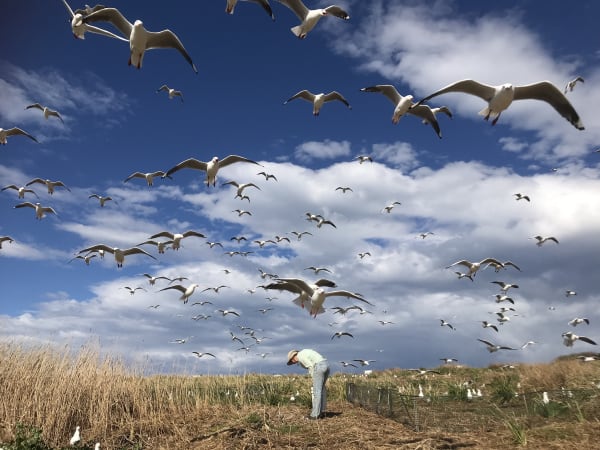
Big-picture thinking
Seabirds show why research needs a big-picture approach.
“An albatross might go 120,000km between breeding seasons,” Bethany said.
“The short-tail shearwaters forage off the Aleutian Islands in Alaska in the northern summer. [In our summertime] the Illawarra is about the northern limit of their distribution. They have very, very large breeding populations as you get into Southern Victoria and into Tasmania and then forage for their chicks down in Antarctica. So they're really linking both poles every year.
“They migrate a lot further than the whales.”
Seabirds’ massive migrations happen mostly out of sight but are immensely valuable, acting as biological pumps, fertilising offshore islands and enriching our waters with nutrients from the Antarctic. We could learn a lot from radar and GPS tracking but research must cover bigger areas, Bethany says.
“There's no point in knowing just the proposed area because you need to know, what does it mean in context?
“You can say that 500 endangered species passed through this area in a certain number of months, but that could be the lowest density and there could be 5000 just off the Royal National Park. Or it could be the highest local density – we just don’t know.”
In Victoria’s 15,000km2 Gippsland wind zone – the first to be declared in Australia in December 2022 – the Department of Climate Change, Energy, the Environment and Water (DCCEEW) has granted 12 feasibility licences to companies including Denmark's Ørsted.
“The problem is,” says Bethany, “they're each gathering the same information, which from an ethical standpoint is completely flawed. It also means that that data isn't publicly available. It’s gathered and the only vetting of it is DCCEEW.
“It's not peer reviewed. That's problematic because that information is fundamental biological information that doesn't exist, which is why each of those operators is gathering it, but they've just got to gather it to the point to satisfy the department – without any transparency, which is really problematic for public trust, and the ethics of each of them handling and tracking hundreds of birds.
“Whereas if you had that as a collective arrangement, which is something that we've been asking for, for a while, then you can capture much more robust data.”

What’s the solution?
UOW scientists are founding members of the new Australian Centre for Offshore Wind Energy (ACOWE). Launched in August, ACOWE would like to assist with robust, transparent, shared research associated with offshore wind.
“That doesn't mean that companies don't pay for it,” Bethany said.
“In Denmark they operate it where part of their licence fee goes into a consortium that is then tasked with doing robust research that's publicly available. The industries and the governments sit, as sort of board members, to discuss what should be researched, but it is collective research rather than tiny little pockets of commercial in-confidence research.”
The Australian Government is not currently funding ACOWE.
So why not?
DCCEEW did not answer this question, only confirming the department is "engaging" with many groups, including ACOWE, and funding requests are considered on a "case-by-case basis".
The Australian economy runs on market-based principles but there's more to it than that, Bethany believes. “A lot of people who are very keen for action on climate change baulk at the idea of any research barriers because they think it would slow down action.”
Bethany compares the polarising process in Australia with the way Scandinavian countries handled it.
“They've been able to – by going in and doing co-design and transparent research – really accelerate their industry in 18 months.
“My concern is with this, if you handle it poorly for offshore wind in these current instances, you can lose public trust… It's not worth burning that. Expediency thinking – oh, we've just got to get this through – can then make decades of trouble for people not trusting science. And that's really problematic.
“I would hate for it to be scuttled just because of an information void. It's probably selling the future of humanity short.”
Want to help add to our knowledge of birds?
Add to the citizen science database at ebird.org
